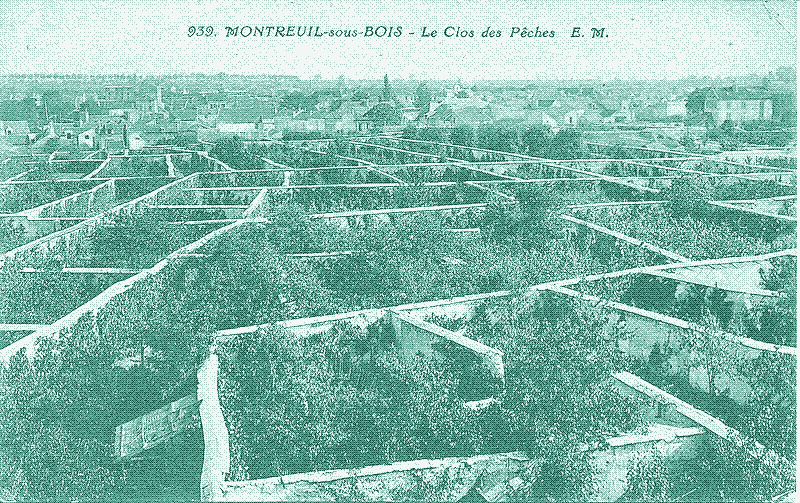
We are being told to eat local and seasonal food, either because other crops have been tranported over long distances, or because they are grown in energy-intensive greenhouses. But it wasn’t always like that. From the sixteenth to the twentieth century, urban farmers grew Mediterranean fruits and vegetables as far north as England and the Netherlands, using only renewable energy.
These crops were grown surrounded by massive “fruit walls”, which stored the heat from the sun and released it at night, creating a microclimate that could increase the temperature by more than 10°C (18°F). Later, greenhouses built against the fruit walls further improved yields from solar energy alone.
It was only at the very end of the nineteenth century that the greenhouse turned into a fully glazed and artificially heated building where heat is lost almost instantaneously – the complete opposite of the technology it evolved from
The modern glass greenhouse, often located in temperate climates where winters can be cold, requires massive inputs of energy, mainly for heating but also for artificial lighting and humidity control.
According to the FAO, crops grown in heated greenhouses have energy intensity demands around 10 to 20 times those of the same crops grown in open fields. A heated greenhouse requires around 40 megajoule of energy to grow one kilogram of fresh produce, such as tomatoes and peppers Source – page 15. This makes greenhouse-grown crops as energy-intensive as pork meat (40-45 MJ/kg in the USA) Source.

In the Netherlands, which is the world’s largest producer of glasshouse grown crops, some 10,500 hectares of greenhouses used 120 petajoules (PJ) of natural gas in 2013 – that’s about half the amount of fossil fuels used by all Dutch passenger cars Source.
The high energy use is hardly surprising. Heating a building that’s entirely made of glass is very energy-intensive, because glass has a very limited insulation value. Each metre square of glass, even if it’s triple glazed, loses ten times as much heat as a wall.
Fruit Walls
The design of the modern greenhouse is strikingly different from its origins in the middle ages 1. Initially, the quest to produce warm-loving crops in temperate regions (and to extend the growing season of local crops) didn’t involve any glass at all. In 1561, Swiss botanist Conrad Gessner described the effect of sun-heated walls on the ripening of figs and currants, which mature faster than when they are planted further from the wall.
Gessner’s observation led to the emergence of the “fruit wall” in Northwestern Europe. By planting fruit trees close to a specially built wall with high thermal mass and southern exposure, a microclimate is created that allows the cultivation of Mediterranean fruits in temperate climates, such as those of Northern France, England, Belgium and the Netherlands.
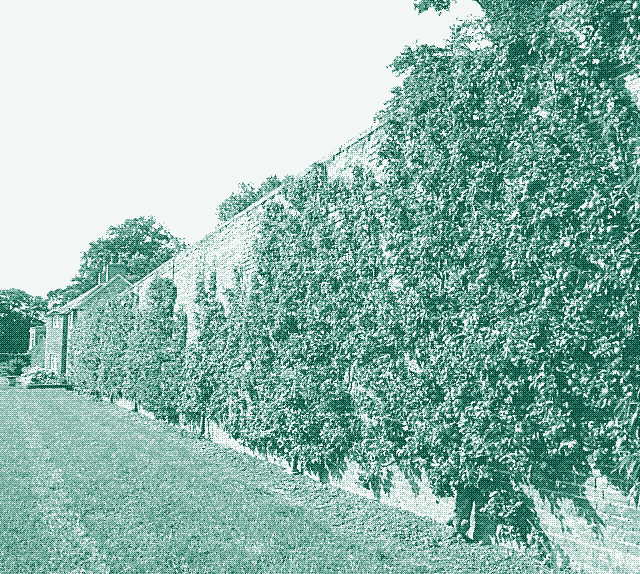
The fruit wall reflects sunlight during the day, improving growing conditions. It also absorbs solar heat, which is slowly released during the night, preventing frost damage. Consequently, a warmer microclimate is created on the southern side of the wall for 24 hours per day.
Fruit walls also protect crops from cold, northern winds. Protruding roof tiles or wooden canopies often shielded the fruit trees from rain, hail and bird droppings. Sometimes, mats could be suspended from the walls in case of bad weather.
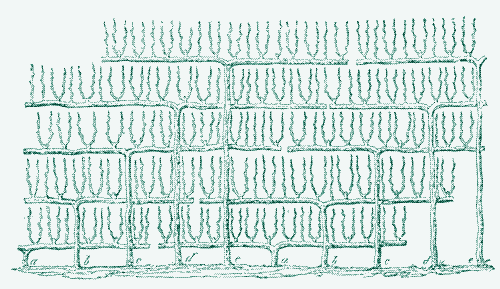
The fruit wall appears around the start of the so-called Little Ice Age, a period of exceptional cold in Europe that lasted from about 1550 to 1850. The French quickly started to refine the technology by pruning the branches of fruit trees in such ways that they could be attached to a wooden frame on the wall.
This practice, which is known as “espalier”, allowed them to optimize the use of available space and to further improve upon the growth conditions. The fruit trees were placed some distance from the wall to give sufficient space for the roots underground and to provide for good air ciculation and pest control above ground.
Peach Walls in Paris
Initially, fruit walls appeared in the gardens of the rich and powerful, such as in the palace of Versailles. However, some French regions later developed an urban farming industry based on fruit walls. The most spectacular example was Montreuil, a suburb of Paris, where peaches were grown on a massive scale.
Established during the seventeenth century, Montreuil had more than 600 km fruit walls in the 1870s, when the industry reached its peak. The 300 hectare maze of jumbled up walls was so confusing for outsiders that the Prussian army went around Montreuil during the siege of Paris in 1870.
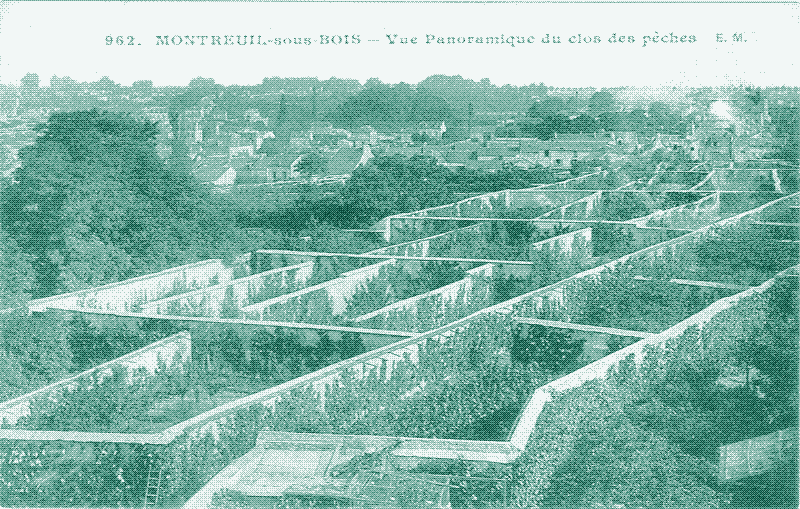
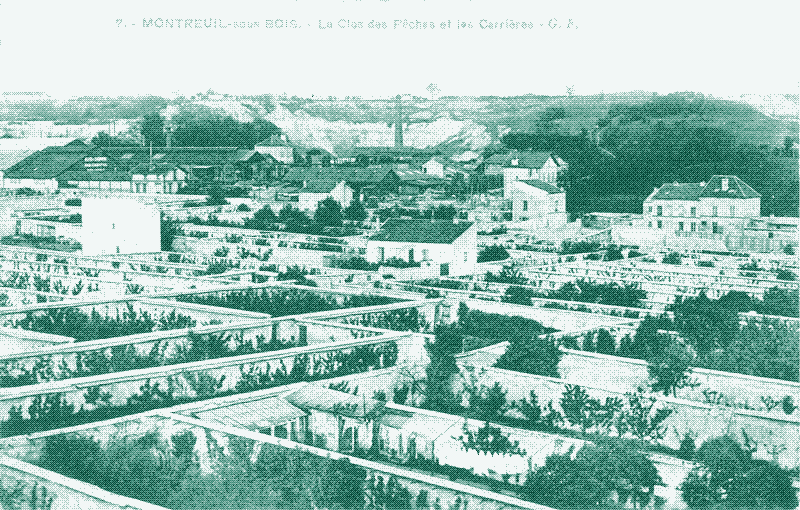
Peaches are native to France’s Mediterranean regions, but Montreuil produced up to 17 million fruits per year, renowned for their quality. Building many fruit walls close to each other further boosted the effectiveness of the technology, because more heat was trapped and wind was kept out almost completely. Within the walled orchards, temperatures were typically 8 to 12°C (14-22°) higher than outside.
The 2.5 to 3 metre high walls were more than half a metre thick and coated in limestone plaster. Mats could be pulled down to insulate the fruits on very cold nights. In the central part of the gardens, crops were grown that tolerated lower temperatures, such as apples, pears, raspberries, vegetables and flowers.
Grapes in Thomery
In 1730, a similar industry was set up for the cultivation of grapes in Thomery, which lies some 60 km south-east from Paris – a very northern area to grow these fruits. At the production peak in the early twentieth century, more than 800 tonnes of grapes were produced on some 300 km of fruit walls, packed together on 150 hectares of land.
The walls, built of clay with a cap of thatch, were 3 metres high and up to 100 metres long, spaced apart 9 to 10 metres. They were all finished by tile copings and some had a small glass canopy.
Because vines demand a dry and warm climate, most fruit walls had a southeastern exposure. A southern exposure would have been the warmest, but in that case the vines would have been exposed to the damp winds and rains coming from the southwest. The western and southwestern walls were used to produce grapes from lower qualities.
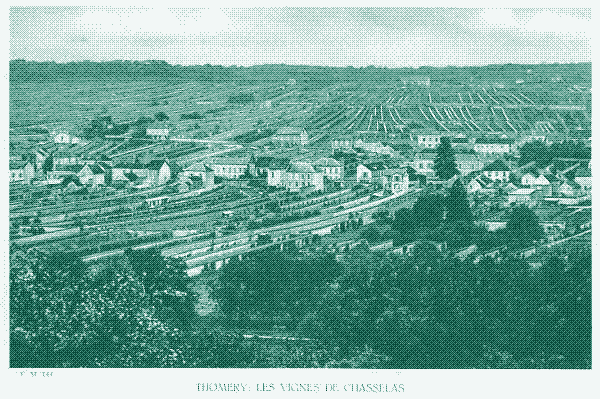
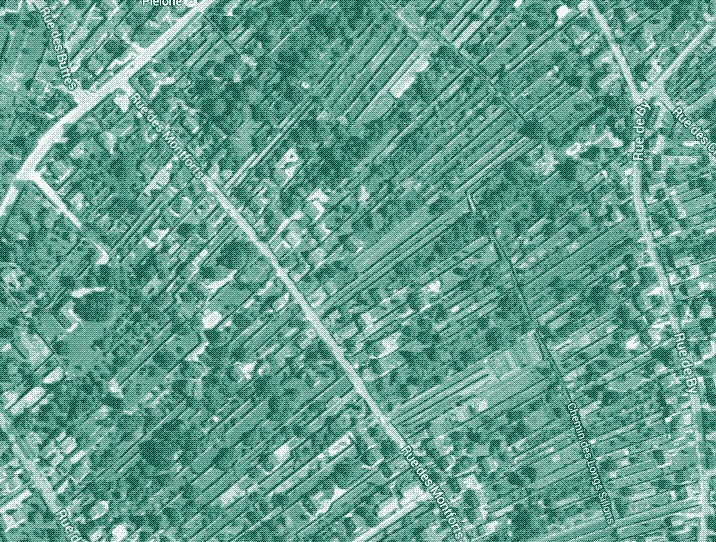
Some cultivators in Thomery also constructed “counter-espaliers”, which were lesser walls opposite the principal fruit walls. These were only 1 metre high and were placed about 1 to 2.5 metres from the fruit wall, further improving the microclimate. In the 1840s, Thomery became known for its advanced techniques to prune the grape vines and attach them to the walls. The craft spread to Montreuil and to other countries.
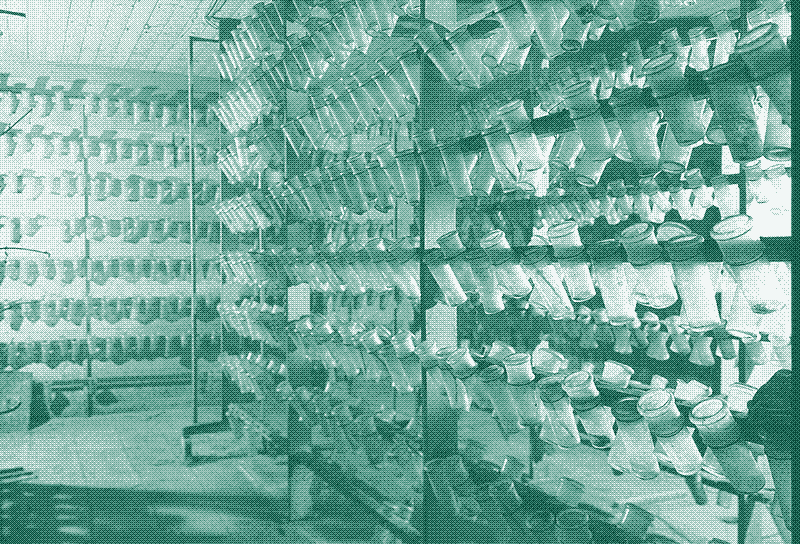
The cultivators of Thomery also developed a remarkable storage system for grapes. The stem was submerged in water-filled bottles, which were stored in large wooden racks in basements or attics of buildings. Some of these storage places had up to 40,000 bottles each holding one or two bunches of grapes. The storage system allowed the grapes to remain fresh for up to six months.
Serpentine Fruit Walls
Fruit wall industries in the Low Countries (present-day Belgium and the Netherlands) were also aimed at producing grapes. From the 1850s onwards, Hoeilaart (nearby Brussels) and the Westland (the region which is now Holland’s largest glasshouse industry) became important producers of table grapes. By 1881, the Westland had 178 km of fruit walls.
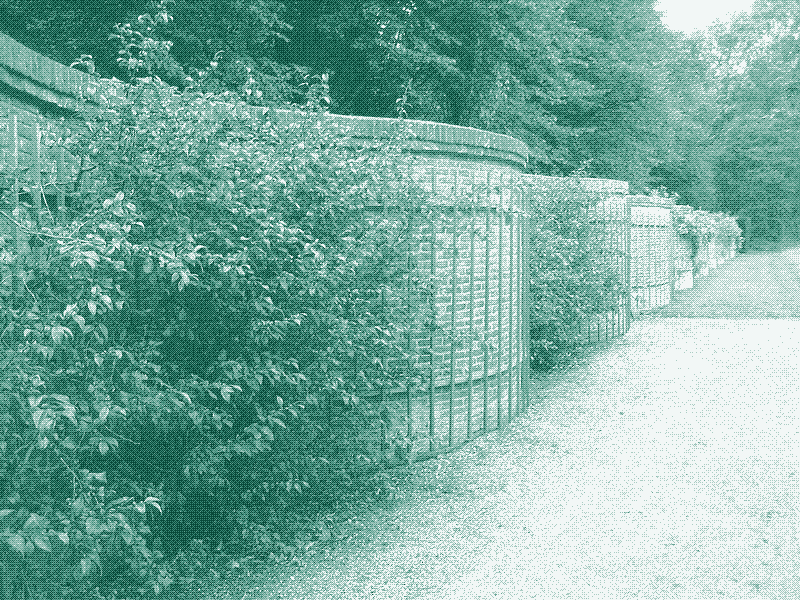
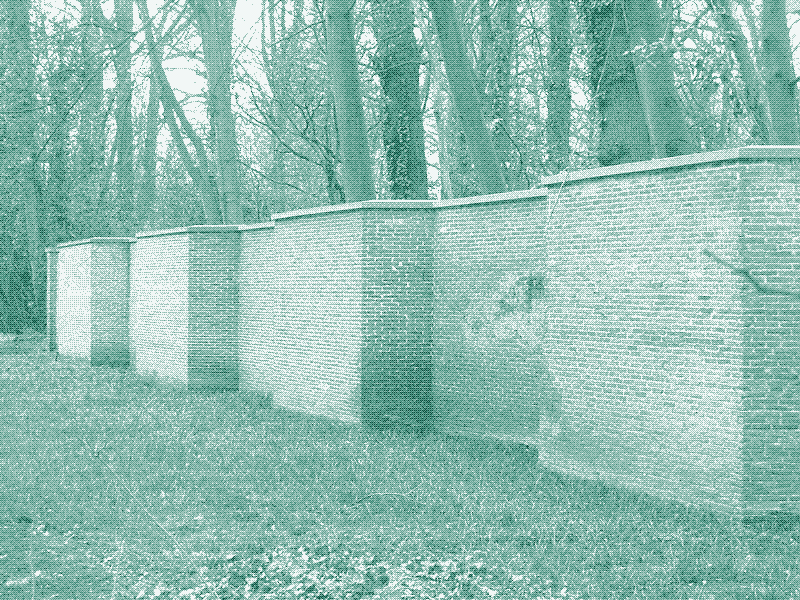
The Dutch also contributed to the development of the fruit wall. They started building fruit walls already during the first half of the eighteenth century, initially only in gardens of castles and country houses. Many of these had unique forms. Most remarkable was the serpentine or “crinkle crankle” wall.
Although it’s actually longer than a linear wall, a serpentine wall economizes on materials because the wall can be made strong enough with just one brick thin. The alternate convex and concave curves in the wall provide stability and help to resist lateral forces. Furthermore, the slopes give a warmer microclimate than a flat wall. This was obviously important for the Dutch, who are almost 400 km north of Paris.
Variants of the serpentine wall had recessed and protruding parts with more angular forms. Few of these seem to have been built outside the Netherlands, with the exception of those erected by the Dutch in the eastern parts of England (two thirds of them in Suffolk county). In their own country, the Dutch built fruit walls as high up north as Groningen (53°N).
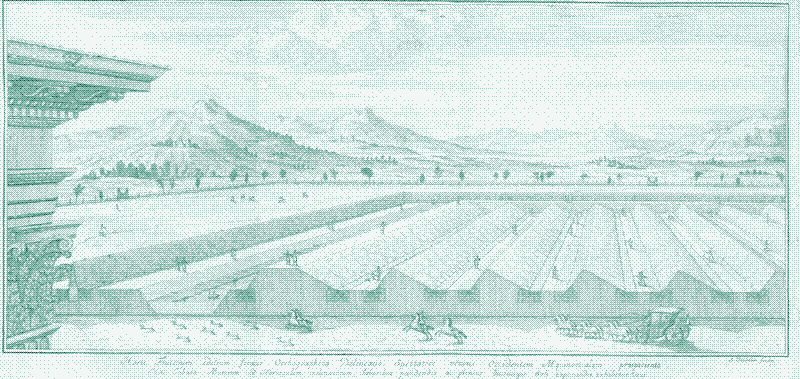
Heated Fruit Walls
In Britain, no large-scale urban farming industries appeared, but the fruit wall became a standard feature of the country house garden from the 1600s onwards. The English developed heated fruit walls in the eighteenth and nineteenth centuries, to ensure that the fruits were not killed by frost and to assist in ripening fruit and maturing wood.
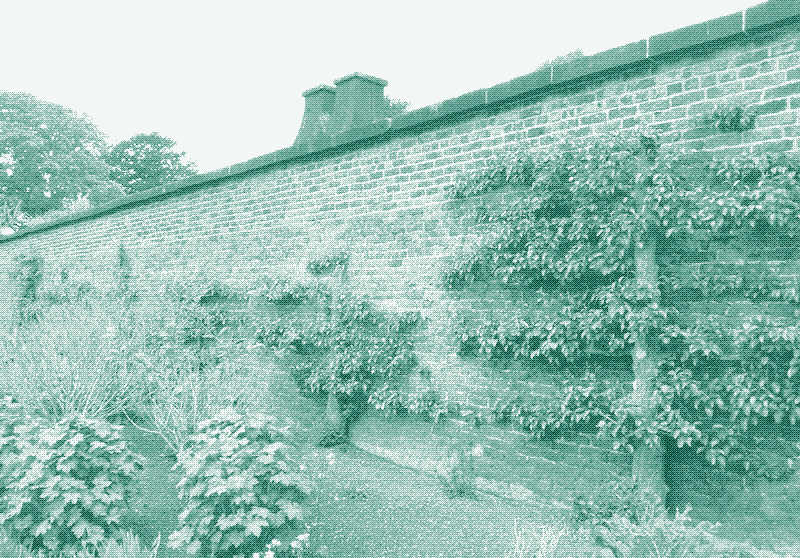
In these “hot walls”, horizontal flues were running to and fro, opening into chimneys on top of the wall. Initially, the hollow walls were heated by fires lit inside, or by small furnaces located at the back of the wall. During the second half of the nineteenth century, more and more heated fruit walls were warmed by hot water pipes.
The decline of the European fruit wall started in the late nineteenth century. Maintaining a fruit wall was a labour-intensive work that required a lot of craftsmanship in pruning, thinning, removing leaves, etcetera. The extension of the railways favoured the import of produce from the south, which was less labour-intensive and thus cheaper to produce. Artificially heated glasshouses could also produce similar or larger yields with much less skilled labour involved.
The Birth of the Greenhouse
Large transparant glass plates were hard to come by during the Middle Ages and early modern period, which limited the use of the greenhouse effect for growing crops. Window panes were usually made of hand-blown plate glass, which could only be produced in small dimensions. To make a large glass plate, the small pieces were combined by placing them in rods or glazing bars.
Nevertheless, European growers made use of small-scale greenhouse methods since the early 1600s. The simplest forms of greenhouses were the “cloche”, a bell-shaped jar or bottomless glass jug that was placed on top of the plants, and the cold- or hotframe, a small seedbed enclosed in a glass-topped box. In the hotframe, decomposing horse manure was added for additional heating.
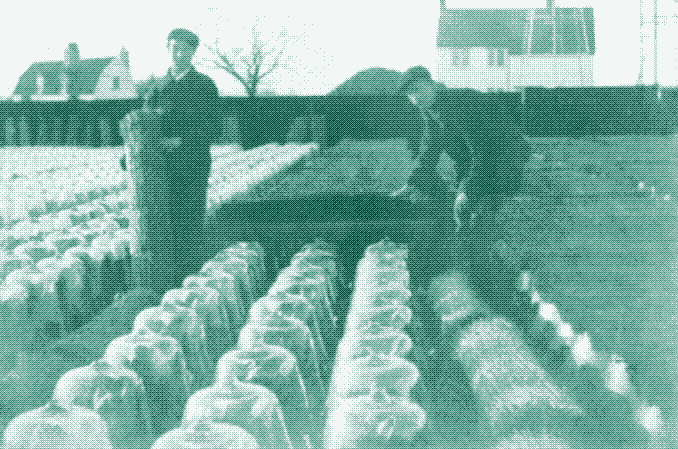
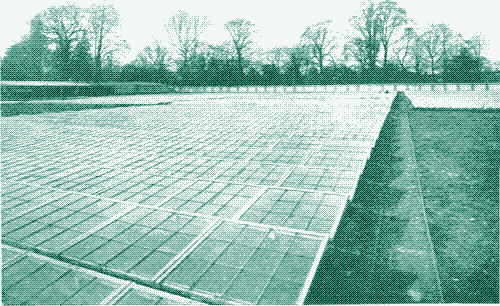
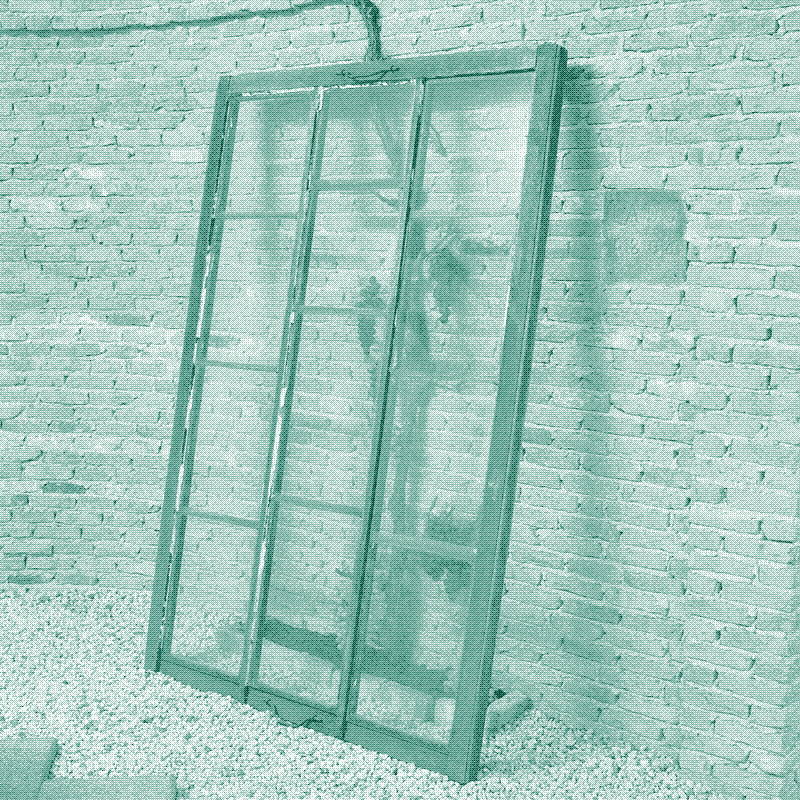
In the 1800s, some Belgian and Dutch cultivators started experimenting with the placement of glass plates against fruit walls, and discovered that this could further boost crop growth. This method gradually developed into the greenhouse, built against a fruit wall. In the Dutch Westland region, the first of these greenhouses were built around 1850. By 1881, some 22 km of the 178 km of fruit walls in the westland was under glass.
These greenhouse structures became larger and more sophisticated over time, but they all kept benefitting from the thermal mass of the fruit wall, which stored heat from the sun for use at night. In addition, many of these structures were provided with insulating mats that could be rolled out over the glass cover at night or during cold, cloudy weather. In short, the early greenhouse was a passive solar building.
](https://solar.lowtechmagazine.com/2015/12/fruit-walls-urban-farming-in-the-1600s/images/dithers/greenhouse-against-serpentine-fruit-wall_dithered.png)
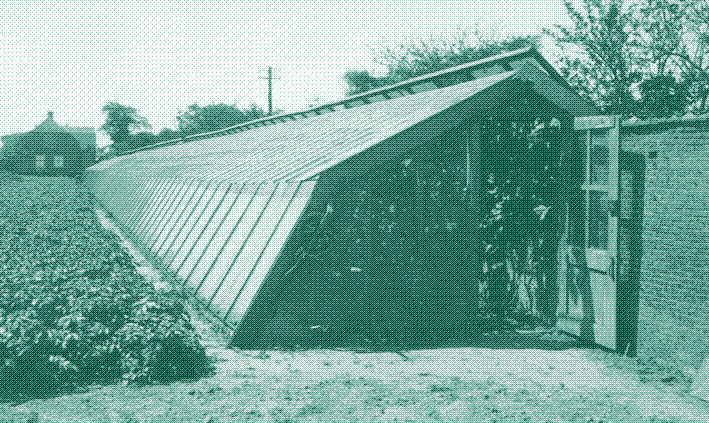
The first all glass greenhouses were built only in the 1890s, first in Belgium, and shortly afterwards in the Netherlands. Two trends played into the hands of the fully glazed greenhouse. The first was the invention of the plate glass production method, which made larger window panes much more affordable. The second was the advance of fossil fuels, which made it possible to keep a glass building warm in spite of the large heat losses.
Consequently, at the start of the twentieth century, the greenhouse became a structure without thermal mass. The fruit wall that had started it all, was now gone.
During the oil crises of the 1970s, there was a renewed interest in the passive solar greenhouse. However, the attention quickly faded when energy prices came down, and the fully glazed greenhouse remained the horticultural workhorse of the Northwestern world. The Chinese, however, built 800,000 hectare of passive solar greenhouses during the last three decades – that’s 80 times the surface area of all glass greenhouses in the Netherlands. We discuss the Chinese greenhouse in the second part of this article.
Sources and more information
Open Air Grape Culture, John Phin, 1862
The last peach orchards of Paris, Messy Nessy, 2014
Geschiedenis van het leifruit in de Lage Landen, Wybe Kuitert, 2004
Onzichtbaar achter glas, Ahmed Benseddik and Marijke Bijl, 2004
Chasselas de Thomery, French Wikipedia
Murs à pêches, French Wikipedia
L’histoire des murs, website Murs à Pêches
Food-Producing Solar Greenhouses, in “An assessment of technology for local development”, 1980
The development and history of horticulture, Edwinna von Bayer
Geschiedenis van Holland, Volume 3, deel 1. Thimo de Nijs, 2003
A Golden Thread: 2500 years of solar architecture and technology, Ken Butti and John Perlin, 2009<
Une histoire des serres: de l’orangerie au palais de cristal, Yves-Marie Allain, 2010
Manual complet du jardinier, Louis Claude Noisette, 1862
Onderhoud en restauratie van historische plantenkassen, Ben Kooij, 2011
Leifruit: toekomst voor eeuwenoude hovernierskunst, Julia Voskuil, 2011
The magic of Britain’s walled gardens, Bunny Guinness, 2014
Visiting the palace of Versailles’ kitchen garden, Janet Eastman, 2015
Hot Walls: An Investigation of Their Construction in Some Northern Kitchen Gardens, Elisabeth Hall, 1989
History of fruit growing, Tom La Dell
Fences of Fruit Trees, Brian Kaller, 2011
Reactions
To make a comment, please send an e-mail to solar (at) lowtechmagazine (dot) com. Your e-mail address is not used for other purposes, and will be deleted after the comment is published. If you don’t want your real name to be published, sign the e-mail with the name you want to appear.
Reactions
Norman
You know this article reminds me of the walled country house kitchen gardens in the UK where vegetable were grown in the middle and fruit not only in the middle but as shown here against the walls.
The idea of the walled gardens, as against hedged or fenced was to keep wild animals and other vermin out. Some even had space inside for domestic animals.
These gardens were usually larger than the ones shown here which appear to be solely for fruit growing. They also often had greenhouses against the walls.
Ludo
Fantastic article and great perspective, as always. Many many thanks for all the time and research that went into it.
Charlie
In England, too, there were glass-covered beds heated by a very thick layer of decomposing farmyard manure (which of course produces a lot of heat) beneath the growing medium. Pineapples were grown in England using this method.
Troy
Since there was little wind moving inside the walled areas, I wonder if fungal diseases were a problem during rainy season. Very cool article :)) useful for my research on urban gardening.
Kaia
Great article - very informative. There I was, thinking that passive solar greenhouses with a wall on the north side, was new. It strikes me that cheap oil has done humanity disservice in addition to climate and pollution problems.
Gerald
I was going to ask if you’d come across any info on the English greenhouses for pineapple growing that were ‘heated’ by horse manure… just what was mentioned in comment #3… (and apparently somewhere in the article where I missed it, but found it mentioned in the follow-up about the Chinese greenhouse).
I wonder if something like that could be combined with aquaponics…
Grant Richard Jones
Thank you creating this wonderfully well-researched article. So much has been overlooked and forgotten due to market convenience.The Korean systems such as the hot-rock on-dol floor are still being used.
Sherwood Botsford
For those of you who are intrigued by this:
A barrel of water weighs about 450 lbs plus 50 pounds of barrel. Water has about 5 times the heat capacity of stone for the same weight, or about twice by volume.
Three barrels high gives 8 feet.
Single file barrels aren’t stable, and they leak are between the barrels. However, it should be possible to embed barrels in an adobe or cobb wall. This would require a cap of some sort.
One of the nuisances is that you need to drain the wall in fall, and refill in spring. A barrel takes a long time to freeze. You are good in fall until highs are frosty. I suspect the easiest way to drain and fill is to leave a chunk of hose in each barrel, or support the wall in a way that leaves one bung exposed for each barrel.
This takes a pile of barrels. But if you can intercept barrels on the way to the land fill, they can cost only the transport.
Metal barrels rust. A metal barrel wall will last only a few decades.
Plastic degrades in sunlight. You want to truly embed it in the wall so that no sun hits the plastic.
Pop bottles are freeze proof, but they expand enough to crack walls. You have to come up with a wall that tolerates movement.
Gabriele Fitzgerald
Thank you for such high quality of research:)
Joe
@ Kris
Thank you very much! I used translate.google.com to provide an English version.
The skill and drive to produce such produce is magnificent!
Joe
john iwaniszek
I wonder what accommodation for bees were made in this type of horticulture.
kris de decker
@ SouthernNM
Well done, great to read this !
Brad Evans
I think it was Jared Diamond’s ‘Collapse’ where I read that Easter Islanders surrounded each plant in their gardens with warmth retaining rocks. A similar idea.
drs
Reminds me of the cucumber frames in Alice in Wonderland.
Deborah Spotts
We visited a passive solar greenhouse in Cheyenne WY: they used a wall on north, stacked black barrels of water on it’s south-facing and glass sloping from top of wall to south. Impressive in that cold, windy local!
eric koperek
Plant a peach tree on the southeast side of a pond (about one 16th acre in size = 50 x 50 feet square and at least 3 feet deep) then mulch the tree with stones 8 inches thick. (Apply rock mulch from the trunk to the “drip line” = the end of the farthest branch). The combination of rocks and water can raise canopy temperatures by 5 degrees Fahrenheit, just enough to prevent frost damage to blossoms. Planting the peach tree near a large boulder, natural cliff, or fruit wall 8 to 10 feet high provides additional frost protection. A south-facing cliff, small pond, and rock mulch can raise canopy temperatures about 18 degrees Fahrenheit. This is how we grow tender fruits in the Austrian Alps. This horticultural technology dates back to the Renaissance. Greek and Roman agronomists also wrote about the warming power of rocks. I have visited commercial orchards in Northern India where apple trees were planted among boulders as big as cars and mobile homes. The trees thrived in the protected micro-climate provided by the huge rocks which not only provide heat but also keep the soil constantly moist. For more information on old-fashioned agricultural methods visit: www.agriculturesolutions.wordpress.com – or – www.worldagriculturesolutions.wordpress.com
Shirley Williams
I have a book by Tim Smit, The Lost Gardens of Heligan, in Cornwall, England and pineapples were grown there before the First World War. My great-uncle farmed in Somerset and he had wonderful peaches that were harvested from trees on a warm brick wall.
Hagbard Celine
Peaches are NOT native to France. They come from southern China and their name relates to the thought that they come from Persia.
Vincent
For those interested, a few “murs de pêches” can still be seen in Montreuil. The place is open to visitors every Sunday afternoon: https://mursapeches.wordpress.com
It’s a small trip from Paris:
www.openstreetmap.org/?mlat=48.86397&mlon=2.45736#map=13/48.8706/2.4447
Seraphine
To know more about the “murs à pêches”, you can visit the “Jardin-école” of the oldest association of Montreuil : the Société régionale d’horticulture de Montreuil, founded by fruit producers in 1878. A lot of tools and documents can be seen in the horticultural museum and the garden is surrounded with peach walls. You can also participate in free gardening workshops. http://www.srhm.fr
@ Joe
About the Thomery practices, you may have further information from the “Association de préfiguration du musée de la vigne”, mponsth@wanadoo.fr or from the “Syndicat d’initiative” of Thomery, si.thomery@wanadoo.fr
… or enjoy the fete dedicated to Saint-Vincent on January the 23rd in Thomery http://www.mairiethomery.com/
Eric Koperek
How to heat a “hot frame” with horse manure: Build hot frame either above or below ground. Traditional hot frames are built underground by digging a 3 foot deep trench to hold fresh horse manure. Length and width of trench is variable depending on size of hot frame. Fill trench with horse manure then compact lightly. Cover fresh manure with at least 8 inches of compost, top soil, or potting soil to protect plant roots from intense heat. Cover glass each night with a blanket of straw or other insulation. 3 feet of fresh horse manure will keep a hot frame heated above 70 degrees Fahrenheit for 6 full weeks = 1 1/2 months in the middle of winter when temperatures are below freezing. (8 inch thick foam insulation can conserve heat for 3 months). Hot beds = hot frames are traditionally used to extend the fall vegetable season or to start early season vegetable crops. You can make a cheap above ground hot bed from bales of hay or straw covered with old window frames or hoops and plastic sheeting. It is also possible to heat glass houses with horse or chicken manure but you need large volumes of manure to make this practical. Pile manure under greenhouse benches or dig out entire greenhouse floor at least 3 feet deep and fill with fresh manure. It is best to use a bobcat or similar machine for this labor. For more information on old-fashioned agricultural technology visit: www.worldagriculturesolutions.wordpress.com – or – www.agriculturesolutions.wordpress.com
Vivi
I live in Eastern Germany, meaning east of the Elbe river, the dividing line between mild maritime climate and harsher continental climate in Central Europe. We still have milder weather than the same lattitude in America (southern Canada), but we do get -20°C nights in some winters and -10°C is normal, at least for a few days or weeks.
This makes it impossible to grow perennial mediterran herbs or frost-sensitive fruit trees (citrus, peaches, etc.) outside without risking losing the plants in any 1 winter out of 4. But on the other hand, you also can’t just simply keep them in pots and carry them indoors in the winter, as they do need some chilling near or right below the frost point. So many people have a so-called “Wintergarten” attached to the southern or western side of their house.
I think the closest English term is “sunroom” - at least there’s a picture of a German Wintergarten on the Wikipedia page of that term. It’s basically an unheated glass greenhouse attached to a wall of the house, like an enclosed patio, so it gets a little warmth from indoors and at the same time absorbs what little sunlight there is in a Northern German winter (November, December and Januar have 50 sunshine hours each or less).
Sometimes, especially in more modern buildings, these rooms also have outside window blinds that are rolled down at night for extra insulation. Though, these days, most of my neighbors actually have installed floor heating and keep palms and such in there, the original purpose was to have a room that’s just kept above about -5°C, to store potted plants that aren’t tropical but wouldn’t survive the occasional hard frost.
My father installed central heating in our Wintergarten and put an insulated roof on top to be able to use it like an extended living room, but I don’t heat it anymore except in emergencies. Aside from overwintering lavender and everything else that doesn’t like its potted soil freezing solid, I keep cold-water fish in there (bathtub-sized tank, so it doesn’t freeze through to the bottom), also because the water serves as thermal mass, slow-grow some frost-hardy salad greens, and use it for starting seedlings a month or two earlier in the spring. (Central Europe has a weather phenomenon called the Ice Saints - 3 days in mid-May that can have freezing nights, even though the frost period otherwise ends in early Arpril and the daytime temperatures easily can go up to 20°C weeks before the Ice Saints. So even though the temperatures generally would allow it, you can’t plant frost-sensitive things like tomatoes and pumpkins out in the garden before late May, shortening the growing season considerably. It helps immensely just to have somewhere frost-free and well-lit to take in the plants in for those few nights.)
Aside from that, we also use one of the south walls of our house as a fruit wall, again because the wall leaks a little extra heat in the winter. And because house walls have an overhanging roof anyway, to keep the whitewash (keeps the house cool in summer) from washing off in the rain. (Though logically, black paint would probably be better for fruit walls? Then again, maybe that would make the surface so hot in summer that the leaves close to the wall would wilt…)
We have a trellis with grapes on our south wall - it never brings much fruit, but that’s more because it hasn’t been pruned properly in 20 years, and because the root zone between the cellar wall and the walkway (which needs a deep sand bed, as flagstones would sink and move on biologically active topsoil) is too small and doesn’t keep water well. Still, the old grapevines have survived many a deep-freezing winter, without any extra covering.
And the small nectarine tree planted against the same wall (though not trellised) carried a lot of fruit until it caught a bad fungal infection due to 2 far-too-warm winters in a row (the spores spread in wet winters) and needed a lot of amputating.
I think my father learned that this was possible, even far north of the German wine growing area (where professionals grow the grapevines on the western slopes of mountains in the Rhine valley, for similar heat-storing effects), from his farmer parents, who also had a few peach trees planted in a walled orchard, just south of Berlin. So it’s probably an old practice here in Central Europe, too.
Also, another origin of the modern greenhouse are the Orangeries that are part of many 17th and 18th century palaces in Germany, even up here in cold Prussia. Some of these palaces are even called “orangery castle”. (I’ve even seen an Orangery in a palace in Moscow!) An Orangery is basically a large, unheated hall with tall windows, designed not to actively grow plants (the roofs are covered, so there’s not enough light), but to store citrus trees in large pots out of the harsh frost.
They were just a luxury indulgement of the very rich, of course, not for large-scale farming. But still, the principle was tested widely, long before buildings entirely made of large glass panes (as in the 19th century conservatories) were feasible, even for princes.
Dj
Thank you all for sharing the article and thanks to all commmentators for their information This is the Internet at its best!
I have a long 30 m wall that’s covered with ivy and I’m now going to use it to grow tender fruits as described in your article and comments . Thanks again.
Margarita Palatnik
I live a block away from the ocean and have a large vegetable garden. I fenced the ocean side with a 6 feet wind-break of wire covered with a white sunscreen fabric. The white reflects the sun and creates the hottest spot in my garden. I have planted berries all along a stretch of this fence, and right now it’s the middle of the winter here (Southern Hemisphere) and my raspberries are all fruiting and ripening, even though we’ve had 4 frosts in the past two weeks. So I can only imagine if my fence had thermal mass, I could be growing tropical fruit!
Thanks much for a lovely, informative, eye-opening article!
Stuart Sachs
I’ve been gardening for 60+ years and have suddenly gotten the urge to build a wall and small greenhouse.
I now want to grow peaches that when you bite into them, you aren’t confused with the things sold in a supermarket that look like a perfect fruit, but taste like a hybrid lemon.
Thank you!
Heather-Gaia Thorpe
The Botabical Gardens in Hobart Tasmania have a wall that has fireplaces in it for additional heat.
Stig Falster
Great article. It also clearly demonstrates the folly of not understanding and learning from our history.
Jenni werner
Inspired to build a wall -interesting questions arise as to when and why walls fell out of favour. Glass hot houses undoubtedly increase volume, but at what cost???
Matt in Oklahoma
Wow great stuff!
Nathalie Paravicini
fabulous article, thank you!
Dalia Beilin-Morel
Excellent Article.It all makes sense. We must get back to these methods. A nation of Gardeners !
Gardening is very therapeutic and rewarding. Even a window box can be a joy.
Edna
Interesting information. I live in Southeast Arizona at about 5000 ft, so have mild winters. We have a greenhouse with insulated roof (some would call it a sun room, but I use it as a greenhouse) attached to the south side of our straw bale home. If the sun shines even a few days per week, the greenhouse supplies all the winter heat our house needs. We have 800 gallons of stored rainwater in drums plus concrete blocks, concrete floor, and earth-plastered wall on the north to supply thermal mass. In summer, we open doors on east and west ends to prevent over-heating. In winter, I can grow tomatoes in pots on carts that I can move to the porch on nice days, but they are never quite as tasty as summer-grown tomatoes. In spring, I start warm-season seedlings in the greenhouse.
SouthernNM
After reading this article two years ago, we put the technology to use. I have a nectarine that had never produced a crop due to late April freezes in our area. My husband and I built a ring of large black local rock just under the drip line of the tree. The ring is about 18 inches wide and tall. For the two summers since, despite late freezes, we have had nectarines. I am really impressed with how much difference the small addition of thermal mass has made. This winter we will build our little walls under an apricot that is also a poor performer!
Kris De Decker
@ SouthernNM
Well done, great to read this !
Arne
I wondered if concrete walls also work. I have a rooftop with a concrete sidewall where I would like to grow tomatoes and fruits.
Darian Sylvester
Enlightening and thought provoking article, well done! Sharing with peers and interested colleagues!